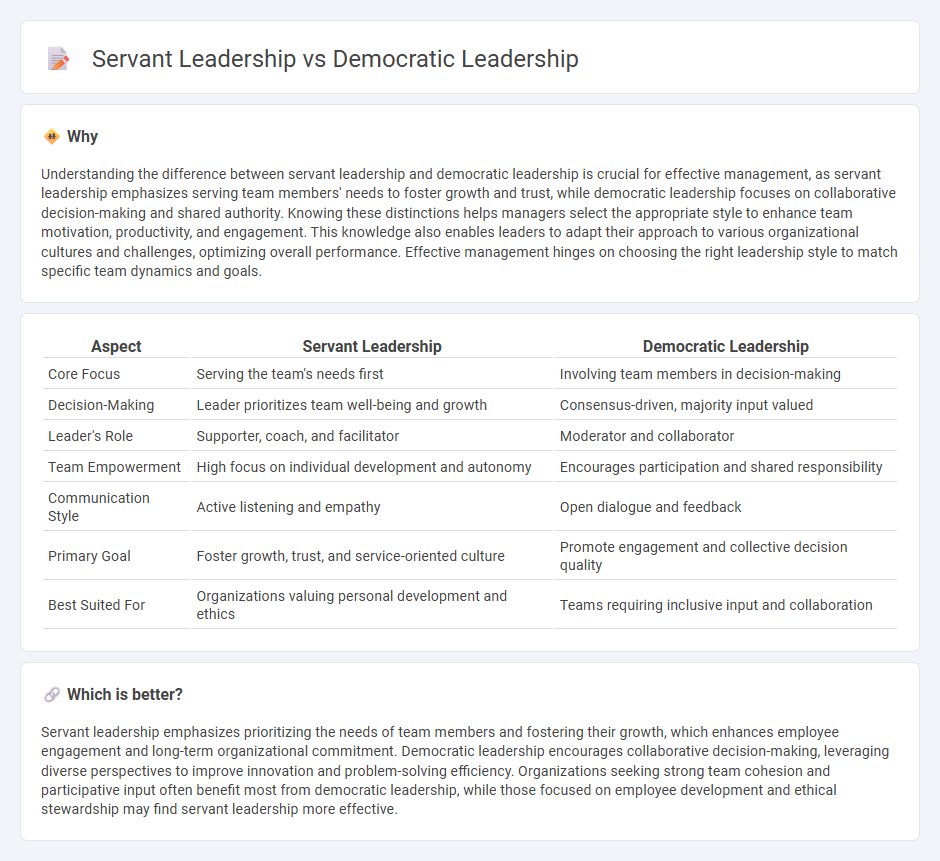
Servant leadership emphasizes prioritizing the needs of team members and fostering their personal growth to enhance organizational performance, while democratic leadership focuses on collaborative decision-making and encouraging active participation from all team members. Both leadership styles drive engagement and accountability but differ in approach--servant leadership nurtures through support and empathy, whereas democratic leadership values shared responsibility and consensus. Explore how these leadership models impact team dynamics and organizational success.
Why it is important
Understanding the difference between servant leadership and democratic leadership is crucial for effective management, as servant leadership emphasizes serving team members' needs to foster growth and trust, while democratic leadership focuses on collaborative decision-making and shared authority. Knowing these distinctions helps managers select the appropriate style to enhance team motivation, productivity, and engagement. This knowledge also enables leaders to adapt their approach to various organizational cultures and challenges, optimizing overall performance. Effective management hinges on choosing the right leadership style to match specific team dynamics and goals.
Comparison Table
| Aspect | Servant Leadership | Democratic Leadership |
|---|---|---|
| Core Focus | Serving the team's needs first | Involving team members in decision-making |
| Decision-Making | Leader prioritizes team well-being and growth | Consensus-driven, majority input valued |
| Leader's Role | Supporter, coach, and facilitator | Moderator and collaborator |
| Team Empowerment | High focus on individual development and autonomy | Encourages participation and shared responsibility |
| Communication Style | Active listening and empathy | Open dialogue and feedback |
| Primary Goal | Foster growth, trust, and service-oriented culture | Promote engagement and collective decision quality |
| Best Suited For | Organizations valuing personal development and ethics | Teams requiring inclusive input and collaboration |
Which is better?
Servant leadership emphasizes prioritizing the needs of team members and fostering their growth, which enhances employee engagement and long-term organizational commitment. Democratic leadership encourages collaborative decision-making, leveraging diverse perspectives to improve innovation and problem-solving efficiency. Organizations seeking strong team cohesion and participative input often benefit most from democratic leadership, while those focused on employee development and ethical stewardship may find servant leadership more effective.
Connection
Servant leadership and democratic leadership both emphasize collaboration, participation, and empowerment of team members in decision-making processes. Servant leaders prioritize the growth and well-being of their team, aligning closely with democratic leadership's focus on fostering open communication and shared responsibility. This connection enhances organizational commitment and drives collective success by valuing employee input and promoting ethical management practices.
Key Terms
Decision-making process
Democratic leadership emphasizes collaborative decision-making by involving team members in discussions to reach consensus, enhancing transparency and shared responsibility. Servant leadership centers on serving the needs of the team first, with leaders prioritizing empathy and support to empower individuals before making decisions. Explore deeper insights into how these leadership styles influence organizational effectiveness and team dynamics.
Authority distribution
Democratic leadership emphasizes shared decision-making and equal authority distribution among team members, promoting collaboration and inclusive participation. Servant leadership prioritizes serving the needs of the team, with authority distributed to empower individuals and foster personal growth. Explore more to understand how these leadership styles impact organizational dynamics and team performance.
Focus on follower needs
Democratic leadership emphasizes active participation by followers in decision-making, fostering a collaborative environment that values diverse perspectives and shared responsibility. Servant leadership prioritizes the holistic growth and well-being of followers, ensuring their needs are met to empower and support their development. Explore more to understand how these leadership styles uniquely address follower needs and enhance organizational culture.
Source and External Links
What is Democratic Leadership? A Simple, Comprehensive Guide - This webpage provides a comprehensive guide to democratic leadership, highlighting its characteristics such as inclusivity, empowerment, and transparency.
The style of democratic leadership - Torch.io - This article explains democratic leadership as a style that involves multiple people in the decision-making process, emphasizing shared responsibility and empowerment.
What Is Democratic Leadership Style? Key Traits & Benefits - This article discusses the democratic leadership style, focusing on inclusive decision-making, empowering team members, and its benefits and challenges in different contexts.
 dowidth.com
dowidth.com